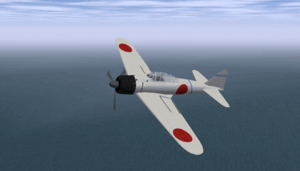The Mitsubishi A6M Zero was a lightweight fighter aircraft operated by the Imperial Japanese Navy Air Service (IJNAS) from 1940 to 1945. The origin of its official designation was that "A" signified a carrier-based fighter, "6" for the sixth such model built for the Imperial Navy, and "M" for the manufacturer, Mitsubishi. The A6M was usually referred to by the Allies as the "Zero" — a name that was frequently misapplied to other Japanese fighters, such as the Nakajima Ki-43 — as well as other codenames and nicknames, including "Zeke", "Hamp" and "Hap".
After the delivery of only 65 planes by November 1940, a further change was worked into the production lines, which introduced folding wingtips to allow them to fit on the aircraft carriers. The resulting Model 21 would become one of the most produced versions early in the war. When the lines switched to updated models, 740 Model 21s were completed by Mitsubishi, and another 800 by Nakajima. Two other versions of the Model 21 were built in small numbers, the Nakajima-built A6M2-N "Rufe" floatplane (based on the model 11 with a slightly modified tail), and the A6M2-K two-seat trainer of which a total of 508 were built by Hitachi and the Sasebo Naval Air Arsenal.
Controls
| Key
|
Function
|
| Ctrl+B
|
Toggle engine boost (2 stages)
|
| Ctrl+D
|
Open / close canopy
|
| Ctrl+L
|
Toggle tailwheel lock
|
| C
|
Catapult launch
|
| O/o
|
Down/up hook
|
| L
|
Engage launch bar
|
| l
|
Open livery dialog
|
Related Content
A6M2 Zero Manual
|
|---|
| | Civilian aircraft | |
|---|
| | Military aircraft | |
|---|
|

